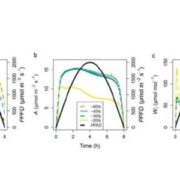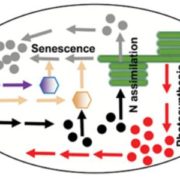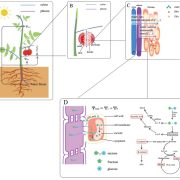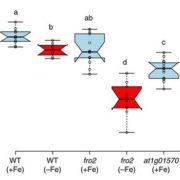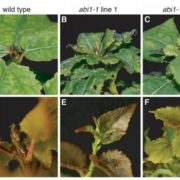Improving on the Humble Spud
The humble spud. Simple, unassuming, yet vital in supporting a large proportion of the world’s population. Historically speaking, much of the research performed on potatoes (Solanum tuberosum) has gone into enhancing their disease resistance, justifiably so given the severe famines brought about through potato blight in the mid-1800s and early 1900s. More recently, however, researchers have turned to studying other aspects of potato development in hopes of enhancing crop yields.
The Green Revolution of the 1960s dramatically enhanced global production of wheat (Triticum aestivum), rice (Oryza sativa), and maize (Zea mays). This increase was brought about (in part) through the development of semidwarf varieties of these crops. The compact structure of these semidwarf varieties made them more resistant to mechanical damage and enabled their planting at much higher densities. Despite the huge gains achieved in these cereal crops, there have been relatively few attempts to apply the concepts of the Green Revolution to potatoes (and tubers in general; Villordon et al., 2014).
In this issue of Plant Physiology, Crocco et al. (2018) report on the overexpression of a B-box transcription factor (AtBBX21) from the model plant species Arabidopsis (Arabidopsis thaliana) in potato. The resulting transgenic lines assumed a short, stocky structure with thick stems and leaves. They had very high levels of chlorophyll and accordingly very efficient photosynthesis. They also accumulated anthocyanins and phenolics, which enabled their photosynthetic machinery to better withstand high light levels. Additionally, these plants responded less to simulated shade, an important trait for plants grown in monoculture. Significantly, the outcome of these phenotypic traits was a 15% increase in tuber yield.
AtBBX21 is a positive regulator of light signaling in Arabidopsis, so it is assumed that its overexpression in potato is comparable to a hyperresponsiveness to light. There have been previous attempts to express other components of the Arabidopsis light signaling pathway in potato, notably the gene encoding the predominant red light photoreceptor phytochrome B (phyB; Thiele et al., 1999; Boccalandro et al., 2003). Overexpression of AtPHYB has many similar effects to overexpression of AtBBX21. AtPHYB overexpressors have a compact phenotype, are more tolerant of competition from their neighbors, photosynthesize more efficiently, and have higher yields (Thiele et al., 1999; Boccalandro et al., 2003). However, it has been shown that AtPHYB overexpression in Arabidopsis is accompanied by a strong reduction in water use efficiency (Boccalandro et al., 2009). Crocco et al. show that overexpression of AtBBX21 in potato has no negative effects on water use efficiency, a crucial trait for a drought-sensitive crop like potato. It may be that overexpression of AtPHYB activates the entire photomorphogenic response, whereas overexpression of a transcriptional regulator like AtBBX21 activates only a subset of this developmental pathway.
Our understanding of what AtBBX21 does on the molecular level is still in its infancy. AtBBX21 belongs to a subset of the BBX protein family (subfamily IV; Crocco and Botto, 2013). The members of subfamily IV have contradictory roles in light signaling, with some promoting and some repressing photomorphogenic development. Members of this group are often thought of as modulators that fine-tune plant responses to abiotic cues (Sarmiento, 2013). We know that AtBBX21 interacts with a key regulator of light responses in plants, ELONGATED HYPOCOTYL5 (AtHY5; Datta et al., 2007). AtBBX21 also promotes AtHY5 expression, and the hyperphotomorphogenic phenotype of an AtBBX21 overexpressor in Arabidopsis is dependent on the presence of AtHY5 (Xu et al., 2016). Therefore, it is possible that the overexpression of AtBBX21 in potato acts to enhance the expression of the native StHY5 gene.
Crocco et al. ascribe the increased tuber number in their AtBBX21 overexpressor lines to an increase in photosynthetic efficiency. However, recent developments suggest that there could also be more direct effects on root development. Root system architecture has a strong effect on tuberization (Villordon et al., 2014), and recent studies in Arabidopsis have shown that AtHY5 directly influences the structure of the root (Chen et al., 2016; van Gelderen et al., 2018). It is therefore tempting to speculate that StHY5 could play a direct role in tuber formation.
Crocco et al. have shown that the modulation of crop traits through heterologous expression of B-box proteins has great promise for the development of new crops. It will be exciting to see if the same approach yields similar benefits in other species.
REFERENCES
Boccalandro HE, Ploschuk EL, Yanovsky MJ, Sánchez RA, Gatz C, Casal JJ (2003) Increased phytochrome B alleviates density effects on tuber yield of field potato crops. Plant Physiol 133: 1539–1546
Boccalandro HE, Rugnone ML, Moreno JE, Ploschuk EL, Serna L, Yanovsky MJ, Casal JJ (2009) Phytochrome B enhances photosynthesis at the expense of water-use efficiency in Arabidopsis. Plant Physiol 150: 1083–1092
Chen X, Yao Q, Gao X, Jiang C, Harberd NP, Fu X (2016) Shoot-to-root mobile transcription factor HY5 coordinates plant carbon and nitrogen acquisition. Curr Biol 26: 640–646
Crocco CD, Ocampo GG, Ploschuk EL, Mantese A, Botto JF (2018) Heterologous expression of AtBBX21 enhances the rate of photosynthesis and alleviates photoinhibition in Solanum tuberosum. Plant Physiol 177: 369–380
Crocco CD, Botto JF (2013) BBX proteins in green plants: insights into their evolution, structure, feature and functional diversification. Gene 531: 44–52
Datta S, Hettiarachchi C, Johansson H, Holm M (2007) SALT TOLERANCE HOMOLOG2, a B-box protein in Arabidopsis that activates transcription and positively regulates light-mediated development. Plant Cell 19: 3242–3255
Sarmiento F (2013) The BBX subfamily IV: additional cogs and sprockets to fine-tune light-dependent development. Plant Signal Behav 8: e23831
Thiele A, Herold M, Lenk I, Quail PH, Gatz C (1999) Heterologous expression of Arabidopsis phytochrome B in transgenic potato influences photosynthetic performance and tuber development. Plant Physiol 120: 73–82
van Gelderen K, Kang C, Paalman R, Keuskamp D, Hayes S, Pierik R (2018) Far-red light detection in the shoot regulates lateral root development through the HY5 transcription factor. Plant Cell 30: 101–116
Villordon AQ, Ginzberg I, Firon N (2014) Root architecture and root and tuber crop productivity. Trends Plant Sci 19: 419–425
Xu D, Jiang Y, Li J, Lin F, Holm M, Deng XW (2016) BBX21, an Arabidopsis B-box protein, directly activates HY5 and is targeted by COP1 for 26S proteasome-mediated degradation. Proc Natl Acad Sci USA 113: 7655 – 7660


